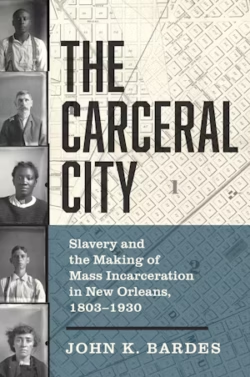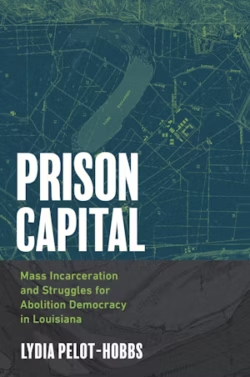“I am not a friend to standing Armies in a free country but we are in a country of Slaves.”
John Watkins, Mayor of New Orleans, 1805
For the past year, I have taught incarcerated students in the Louisiana penitentiary system through a prison education program. Every week, I make the roughly two-hour trek from New Orleans to a rural parish just north of Bogalusa—a four-hour round trip that keeps many of the inmates from regularly receiving visitors. I know I’m getting close to the prison when the air becomes putrid from the unmistakable smell of a paper mill, a stark reminder as to why the prison is here in the first place.
Perhaps surprising to most, much of Louisiana has been historically reliant on timber (mostly pine) extraction and processing. Bogalusa’s original saw mill was once the largest in the world. Timber work in the South has always relied on an interracial workforce, making the industry home to some of the first interracial labor unions in the country. The Brotherhood of Timber Workers, one of the largest affiliates of the revolutionary Industrial Workers of the World, had roughly thirty thousand Black and white members primarily concentrated in Louisiana and Texas. By 1919, the mill workers in Bogalusa joined a nationwide wave of labor militancy by going on strike—a strike that was ultimately broken by a company-sponsored militia and a decades-long resurgence of the Ku Klux Klan.
By the 1960s, international trends toward automation and outsourcing hit Bogalusa’s majority Black population especially hard. Employment at the mill—essentially the only large employer in the region—declined exponentially, leading to an intense increase in unemployment, poverty, and crime. In 1982 a “savior” emerged: the prison. Today, it is one of, if not the, largest employers in the region. There is unmistakable irony—an irony not lost on the incarcerated themselves—that the prison “saved” many of the residents of Bogalusa from a life of incarceration by offering them relatively stable employment. They know that one’s position on either side of the bars is more luck of the draw than anything else. If only a prison had been built where they once lived!
The self-perpetuating nature of prison labor mirrors this perverse logic of “saving” communities by making them economically dependent on the maintenance (if not the expansion) of mass incarceration. Unlike the sloppy caricatures painted by (probably) well-meaning liberals in mainstream exposés like the Netflix documentary 13th, an overwhelming majority of prison inmates do not perform uncompensated labor for private for-profit corporations.1“13TH,” YouTube video, 140:02, posted by “Netflix,” April 17, 2020, https://www.youtube.com/watch?v=krfcq5pF8u8. They are, however, expected to perform uncompensated labor. In Louisiana, when convicted of a crime, one is quite literally—and this is the actual verbiage used in convictions—sentenced to “hard labor.” This hard labor, though, is primarily used for the reproduction of the prison itself. The goal is to make mass incarceration cost as little as possible for the taxpayer. If that means virtually enslaving the incarcerated to ensure the prison is maintained as cheaply as possible, so be it.
***
If I have learned one thing living in and studying the US South, it is that, contrary to popular and academic stereotypes of backwardness, docility, and a lack of class consciousness, workers in the South are vividly aware and deeply resentful of their place in society. It is precisely because southern workers are so militant that the most oppressive social and political structures are designed to contain and suppress them. Massive insurrectional revolts in colonial Virginia led to the invention of what we now call “white supremacy” to divide and conquer a united force of European indentured servants and African slaves; an economic and political alliance of white and Black sharecroppers throughout the South in the late nineteenth century necessitated the creation of Jim Crow, again, to divide and conquer the southern working class; while the explosion of the southern labor movement in the 1930s and 1940s led to a racialized New Deal and a reinvigoration of white supremacist violence.2Theodore W. Allen, The Invention of the White Race: The Origin of Racial Oppression, (New York: Verso, 2021); C. Vann Woodward, The Strange Career of Jim Crow: Commemorative Edition (Cambridge: Oxford University Press, 2001); Cody R. Melcher and Michael Goldfield, “Moments of Rupture: The 1930s and the Great Depression,” Convergence, November 9, 2021, https://convergencemag.com/articles/moments-of-rupture-the-1930s-and-the-great-depression/. It was not random or inevitable that the Klan would flourish in places like Bogalusa; employers needed it to.
All of this is to say that the South has often been on the cutting edge in the suppression of working class militancy. The South is not backwards; if anything, labor relations in the South have predicted and influenced the behavior of northern capitalists for hundreds of years. This is the shared thesis of two new books on mass incarceration in Louisiana: John K. Bardes’ The Carceral City and Lydia Pelot-Hobbs’ Prison Capital.
Both works, while covering dramatically different eras of incarceration, show that the mass expansion of the prison is tied directly to ruling-class fear of working-class rebellion and resistance. Because resistance is most intense in the South, technologies of oppression—like the first professionalized police force, the chain gang, creative solutions to prison overcrowding, if not the prison itself—were first developed in the South, only to be later copied in the North. As national policies continue to mimic the regressive politics once reserved for the “backward” South, it becomes clear that the South is not stuck in some sort of premodern mire, but rather a harbinger of what is to come.



